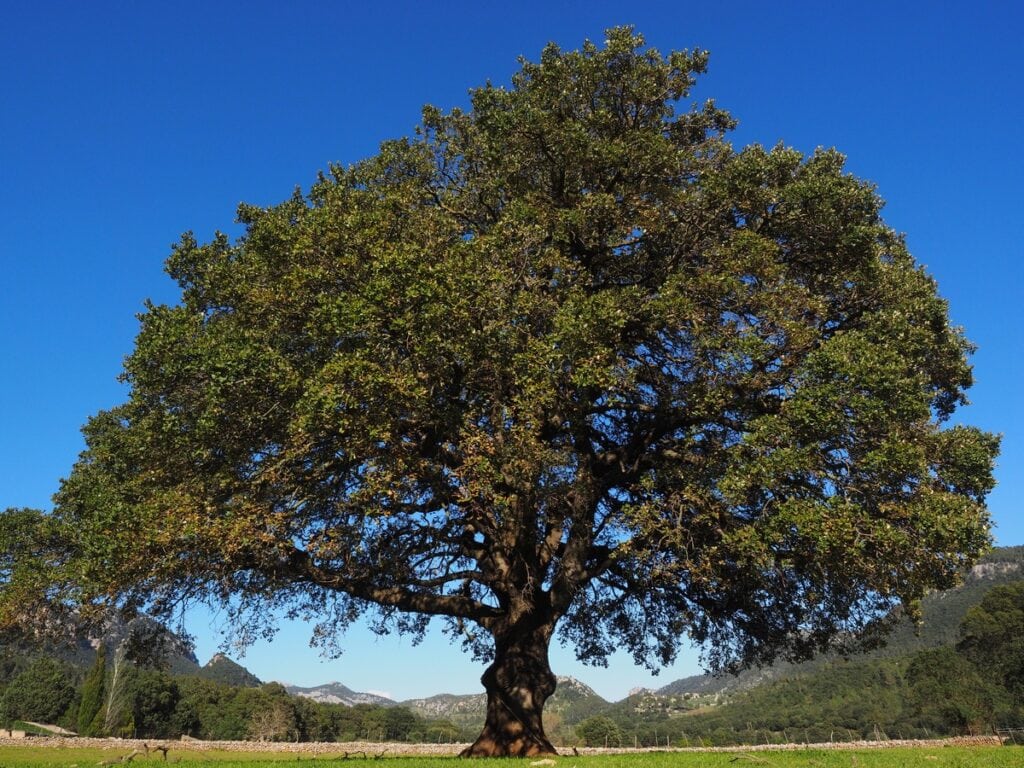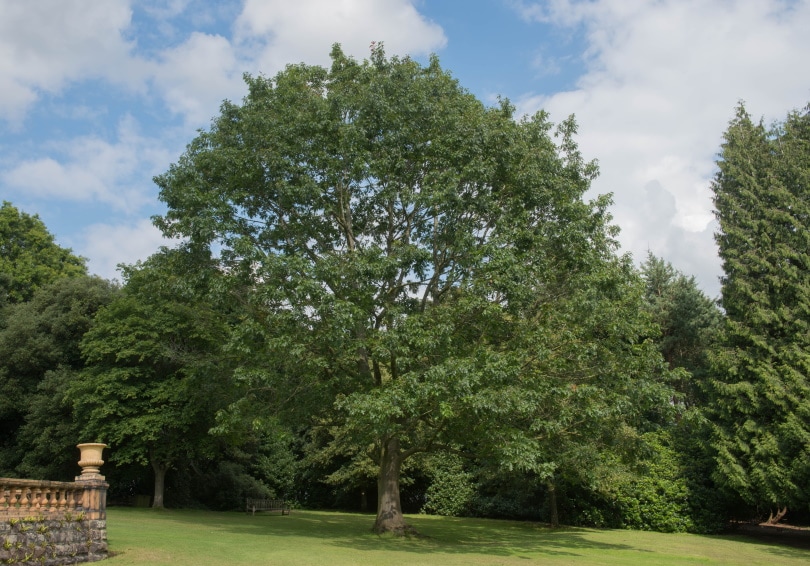How Fast Do Oak Trees Grow? Timeline, Varieties, & Tips
-

- Last updated:

A shade tree makes a beautiful and practical addition to nearly any backyard. With lengthy lifespans and voluminous growth, oak trees are perfect for planting in spacious lawns, as long as you’re willing to wait. Most oaks grow relatively slowly, only averaging around 1 foot in height per year, and it can take decades to see significant size development.
Those minor gains may not be appealing if you want a usable arbor in a reasonable amount of time. Among the assorted types of oaks, you’ll find many that grow to full size in a fraction of the time of those slower-growing varieties. If you want to bring the grace and robustness of an oak tree to your yard, we’ll show you how you can get a towering specimen in no time.
 How Fast Do Oak Trees Grow?
How Fast Do Oak Trees Grow?
Most popular oak varieties have a slow–medium growth rate of 1–2 feet per year. White oaks (Quercus alba), one of the most ecologically and commercially important oak varieties, often take over a decade to grow 20 feet tall.
The slow growth rate is one reason oaks are so appealing. Their deep roots and dense wood allow them to withstand weather and abuse for hundreds of years while growing impressively large. With their stature, widespread canopy, and gorgeous fall foliage, mature oaks can be some of the most attractive trees for your property.

Oak Growth Timeline
An oak tree can take anywhere from 6 months to 3 years to reach 3 feet and become a sapling, depending on the variety. It will take another 40 years or more to grow to its mature height. White oaks can reach maturity at about 50–80 feet, but it isn’t uncommon for them to eclipse 100 feet in height.
Fortunately, not all oak trees are created equal. Although white oaks take several decades to mature, several oak species can grow in half that time or even faster. As an example, the northern red oak can reach 80 feet at its mature height but grows 24–36 inches per year. The fastest growing oaks cap at about 3–4 feet annually.
Fast-Growing Oak Tree Varieties
| Hardiness Zone | Annual Growth Rate | Life Span | Mature Height | Mature Width | |
| Nuttall Oak | 5–9 | 24 inches | 100 years | 40–60 feet | 35–50 feet |
| Monterrey Oak (Mexican White Oak) | 7–10 | 30–48 inches | 100 years | 40–50 feet | 35 feet |
| California White Oak (Valley Oak) | 7–11 | 24 inches | 200 years | 40–70 feet | 60 feet |
| Southern Red Oak | 6–9 | 24–36 inches | 150 years | 60–80 feet | 50–60 feet |
| Laurel Oak | 6–10 | 24 inches | 50–70 years | 60–70 feet | 35–45 feet |
| Pin Oak | 4–8 | 24 inches | 150 years | 60–70 feet | 25–40 feet |
| Sawtooth Oak | 5–9 | 12–36 inches | 100 years | 60–70 feet | 40–60 feet |
| Water Oak | 6–9 | 24 inches | 30–50 years | 50–80 feet | 50–80 feet |
| Willow Oak | 5–9 | 24 inches | 100 years | 40–60 feet | 30–40 feet |

How Tall Is An Oak Tree After 10 Years?
Depending on the variety, you may have a tall, shady tree after only 10 years, or the sapling could be no taller than a basketball hoop. White oak will only grow 10–15 feet in ten years. Red oaks can nearly double that rate, often reaching more than 20 feet in the same period.
Certain oaks grow even faster in the right conditions. A Monterrey oak, for instance, can reach a mature height of 50 feet in less than 20 years. If your climate allows, you can grow a thriving, long-lasting shade tree in only a few years.
The 4 Tips for Improving Oak Tree Growth
The best way to achieve a tall tree in short order is to choose a quick-growing variety. No matter how well you take care of an oak tree, each species can only develop quickly. With that said, following a few essential maintenance steps is crucial to ensure your oak tree grows as fast as possible, regardless of which variety you’re planting.
1. Plant the Right Oak Tree
Before choosing the fastest-growing oak tree that can survive in your zone, you’ll need to take stock of the environment. Oak trees vary in their tolerance to disease, water availability, soil conditions, and other variables.
Some oak trees may, for example, be more comfortable in coastal areas, while others may grow high in the mountains. A normally fast-growing oak will grow much slower if not given its ideal growing conditions.
Planning a spot for the tree will help you whittle down viable candidates. You’ll need enough room to accommodate the canopy, and given the wide size gaps between many oak species, it’s likely that only a few varieties will make sense in your yard.
If you’re unsure which fast-growing variety to plant on your lawn, check around the neighborhood for oak trees. Download an app like LeafSnap to your phone, and you can readily identify oak trees that grow well in your area. Nurseries are also excellent starting points for getting plants and local knowledge on growing oaks.
2. Provide Appropriate Soil and Sunlight

Oak trees will grow their fastest in full sun with plenty of well-drained soil so they can spread their roots. Some oak trees are more tolerant of shade if you have limited options, but they all do their best when they receive at least 6–8 hours of daily sunlight.
Soils should be humus-rich and well-drained. Many oaks are adaptable to adverse soil conditions, especially once established, but higher-quality soil will always help them fare better. Along with the soil condition, it’s crucial to give your trees adequate space from structures and other plants to accommodate their size and avoid competition with their roots.
3. Use a Nitrogen-Rich Fertilizer
Young oak trees need help staying healthy. Unlike mature oaks, which typically don’t need any fertilizer or added watering, young trees don’t have advanced root systems to extract the necessary nutrients to thrive. It may continue growing without it, but you can speed up your oak tree’s development nearly every time by adding fertilizer.
Apply a 12-4-8 or 12-6-6 slow-release fertilizer in the spring when the trees are young. A nitrogen-rich fertilizer is essential in promoting the fastest growth possible, but moderation is crucial to prevent damage and ensure a healthy balance of root and top growth. As they grow, oaks will also receive an enhancement from their fallen leaves, acorns, and twigs.
4. Pruning

Pruning is an excellent way to get your oak tree to focus on upward growth. When the tree is young, you should prune it once every 2–3 years, focusing on removing branches that may compete with the leader for nutrients. By taking out thicker side branches, you can keep the growth directed up, reserving all of the tree’s energy for the central stem.
Thinning buds and removing branches in whorls can also push oaks to grow faster. Rub away clusters of buds until one healthy bud is left, giving it only one direction to grow and allowing the tree to grow more efficiently. Perform pruning during winter to prevent oak wilt disease from attacking the tree when it is most vulnerable.
Pruning is often less of a necessity when your tree is mature. At this stage, you may only want to remove dead or diseased branches as needed. As pruning becomes more complex, you may consider contacting a trained expert for help.
 Conclusion
Conclusion
Oak trees may have a reputation for being slow growers, but there’s likely a surprisingly speedy variety that can thrive in your backyard. Unlike many other trees, oaks grow quickly without sacrificing longevity. Follow these tips for maximizing your tree’s growth, and start enjoying a thriving tree and abundant supply of shade sooner rather than later.
See also:
Featured Image Credit: Alexander Tolstykh, Shutterstock
Contents
 How Fast Do Oak Trees Grow?
How Fast Do Oak Trees Grow?